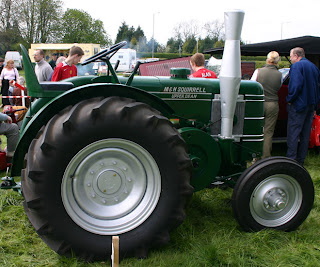Tractors can be generally classified as two-wheel drive, two-wheel drive with front wheel assist, four-wheel drive (often with articulated steering), or track tractors (with either two or four powered rubber tracks).
The classic farm tractor is a simple open vehicle, with two very large driving wheels on an axle below and slightly behind a single seat (the seat and steering wheel consequently are in the center), and the engine in front of the driver, with two steerable wheels below the engine compartment. This basic design has remained unchanged for a number of years, but enclosed cabs are fitted on almost all modern models, for reasons of operator safety and comfort.
A 1958 Series II Field Marshall--the classic standard tread farm tractor configuration
In some localities with heavy or wet soils, notably in the Central Valley of California, the "Caterpillar" or"crawler" type of tracked tractor became popular in the 1930s, due to superior traction and floatation. These were usually maneuvered through the use of turning brake pedals and separate track clutches operated by levers rather than a steering wheel.
Four-wheel drive tractors began to appear in the 1960s. Some four-wheel drive tractors have the standard "two large, two small" configuration typical of smaller tractors, while some have four large powered wheels. The larger tractors are typically an articulated center-hinged design steered by hydraulic cylinders that move the forward power unit while the trailing unit is not steered separately.
In the early 21st century, articulated or non-articulated, steerable multi-track "tractors" have largely supplanted the "Caterpillar" type for farm use. Larger types of modern farm tractors include articulated four wheel or eight wheel drive units with one or two power units which are hinged in the middle and steered by hydraulic clutches or pumps. A relatively recent development is the replacement of wheels or steel crawler-type tracks with flexible steel-reinforced rubber tracks, usually powered by hydrostatic or completely hydraulic driving mechanisms. The configuration of these tractors bears little resemblance to the classic farm tractor design.


No comments:
Post a Comment